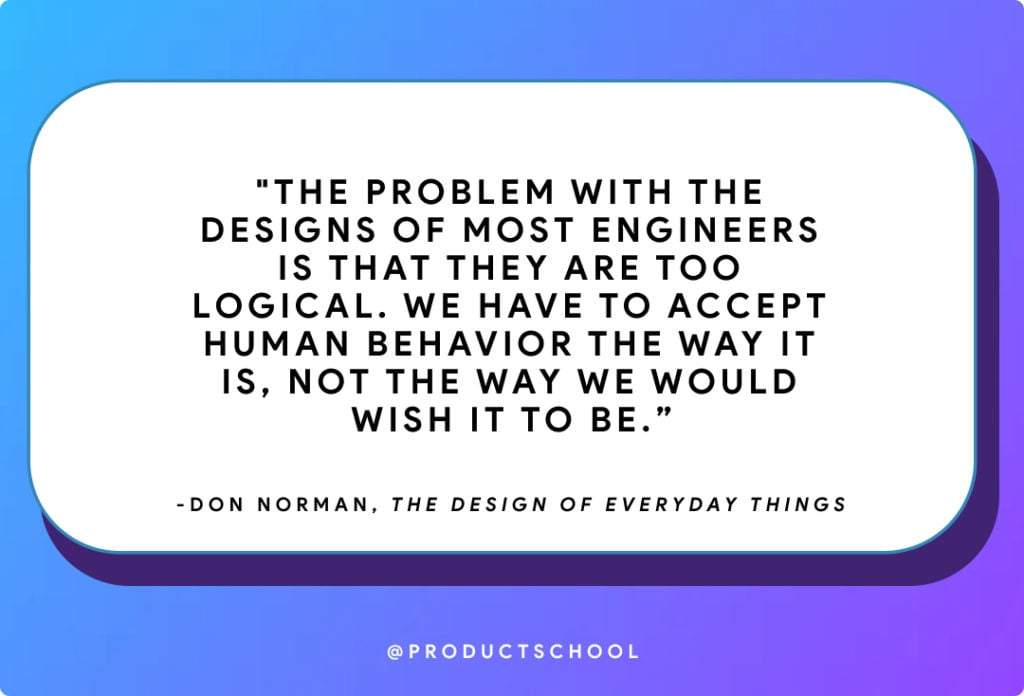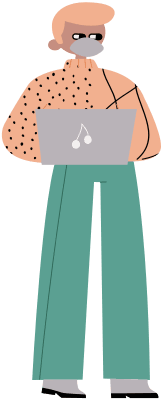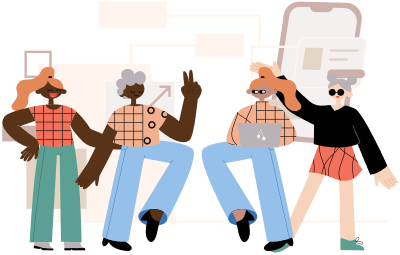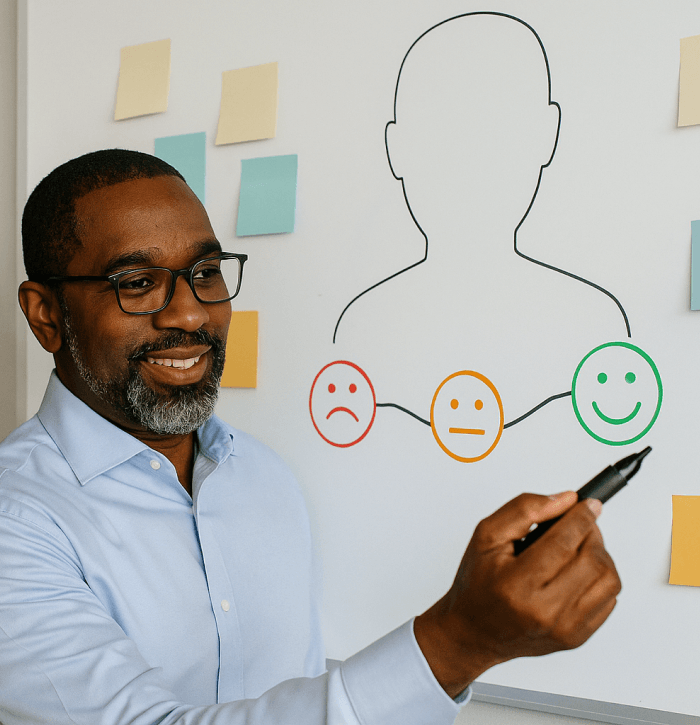Updated: January 24, 2024- 9 min read
You’ll find yourself working closely with UX and UI designers throughout your career as a Product Manager. While you won’t be expected to know everything about product design (otherwise, you’d be a designer, right?) there are at least a couple of key things you should have a solid grasp on.
The last thing you want to do when talking to a designer, is to use UX and UI interchangeably. That’s a big mistake! It’s like if someone was talking to you and thought that an MVP and a prototype are the same thing. Or that an OKR is the same as a KPI.
It’s roughly in the ballpark of being right, and these keywords help you sound like you know what you’re talking about…so long as there aren’t any experts in the room!
UX (User Experience) and UI (User Interface) design are, in the grand scope of tech roles, somewhat similar. But they are actually two different disciplines.

Today we’re going to tell you everything you need to know about the main differences between UX and UI, so you can be sure to never make such an embarrassing mistake again!
You may also be interested in: Why UX Is Essential for PMs
What Is UX?
UX, or User Experience design, was first laid out by Don Norman in his 1988 book The Design of Everyday Things. The term blew up in the mid-1990s when Norman worked at Apple, and the shift toward user-centric design took over the product world.
UX, as detailed by Norman, is everything that a customer experiences with a company, from first introduction to onboarding, throughout their relationship with the company. It’s about more than just ‘did the product solve my problem?’ it’s about how the product made them feel throughout.
In 2013, Norman updated and expanded his book to be more inclusive of digital products and services, to reflect the shift from hardware to software. The book remains a sort of timeless modern-day product design bible, as it discusses the theory and principles behind design rather than current trends.
One of the main lessons that shifted the way product people think about design, is that we first have to understand the user and build the product they want, rather than just building something that solves a problem and expecting the users to accept the design as-is.

As well as being user-centric, UX design is human-centric, which means understanding that people’s needs, wants, thoughts, and feelings should all be taken into account when designing an experience for them.
Another important part of product development that we have Norman to thank for is iteration. The user-centric design calls for users to be more heavily involved in the research and development process, meaning that designers can constantly be testing ideas and improving the experience.
The UX Honeycomb
Peter Moreville created a brilliant visualization of the seven essential aspects of great UX. Well-designed products are useful, desirable, accessible, credible, findable, usable, and therefore valuable.
Many of the elements of UX can also be extended to UI.
Want to know more? Check out What Is Product Design?
What Does a UX Designer Do?
We’ve been through the definition of UX in the abstract, and that’s useful, but it doesn’t give much clarity on what a UX Designer actually does.
UX Designers are sometimes also known as Product Designers (especially in the Silicon Valley tech industry), and they are primarily responsible for designing apps/software that solve a problem or provide a service.
They do this mostly through conducting user research, working closely with the UI designers (we’ll get to them soon!), and communicating designs and requirements to developers.
UX Designer, along with Product Manager, is an attractive role for creative people with a passion for tech who don’t necessarily know how to code. They may be confused with Web Designers, and many of those in UX got their start in Web Design.

A UX Designers day-to-day might involve:
Concept and usability testing
Creating user personas with the Product Manager
User research (interviews, surveys, etc.)
Market and competitor research
Developing wireframes and prototypes
You might also be interested in: Product Managers – Here’s How To Make Your Designers Love You
What Is UI?
User Interface (UI) Design is unique to digital products, as the designer focuses on the actual graphical user interfaces of a product. Be it for mobile apps or desktop software, users interact with a variety of components within a product, like menus, buttons, videos, forms…anything you can swipe, scroll, or click on.
UI is absolutely vital for UX (and vice versa, as we’ll get to next.) UI Designers are a kind of Graphic Designer, as they choose things like color schemes, fonts, line spacing, transitions, and many more components of a user interface.
Great UI design is a combination of solid UX and a user interface that makes sense. It has to be aesthetically pleasing, functional, and discoverable. Target users should be able to take one look at the screen and know what they’re supposed to do next.
What Does a UI Designer Do?
As we said, a UI Designer works on the visual design of a digital interface.

Their day to day tasks may include:
Conducting user research
Designing aesthetic elements and overall layouts
Track the human-computer interaction (HCI) of a design
Run tests on designs and gather data
Analyze web data and recommend improvements/iterations
How Do UX and UI Work Together?
Perhaps it would be appropriate to liken digital product development to building a house. A UX Designer is like the architect, who thinks about how human beings use houses, who will use this particular house, and what their overall experience of the house should be.
The Engineers are the builders who actually…build. The Product Manager is the site manager, who makes sure that everyone is working in harmony.
The UI Designer is the interior designer, who works out which door handles to use, which way the windows are going to open, which rooms will have carpet and which will have tiles, what color to paint the walls, and so on.
UX and UI are equally essential for the success of a product. Without a UI Designer, you’re left with black-and-white wireframes with no graphic design, and the user will not enjoy using it…or even know how to use it!
Without a UX Designer, you’ve just got a random collection of buttons and menus, with no thought behind them.
The two disciplines need to work together in harmony, and UI should always follow UX.
UX and UI Designers work together especially closely when the time comes to iterate. If something about the UX changes, the UI will need to be redesigned to reflect that. And if UI changes are needing, the information architecture may also need to be changed to make it work.
Research
One of the cornerstones of both great UX and UI is research, but the two disciplines need different information.
Users are getting more and more tech-savvy, meaning that they have expectations of how a product should operate before they’ve even downloaded it. When your product strays too far from those expectations, you run the risk of confusing or disappointing your users, which leads to swift abandonment. So UX Designers need to know what functionality and information architecture will best resonate with customers.
UI Designers also need to know what people expect but from a more visual standpoint. Are they more likely to click on a hamburger menu or a tabbed menu?
They’ll gather this information from a combination of interviews and surveys, and A/B testing.
What Does Good Design Look Like?
Great product design, much like many things in the product industry, is something that the customer barely notices. When you get them from A to B, without them having to think too hard about how they got there, is a sign of good design.

A great example of this can be taken straight from Norman’s book. If you think about the last time you crossed a road, do you remember pushing the button at the crosswalk?
The idea of the button is relatively simple – you need a way to tell the cars to stop so that you and other pedestrians can get to the other side safely. If the button achieves that, then it has solved the problem.
But some cities have bad feedback design built into the system, and the button doesn’t tell you when it has been pressed. This leads everyone who walks up to the crosswalk to push the button repeatedly. Someone may even assume that the button has already been pressed, leaving them stuck waiting on the side of the road for a green man who is never going to come.
But some cities have lights or sounds to make it clear that the button has been pressed. If you live in one of these cities, you’ve probably never even thought about the lights or sounds. You’ve simply had a seamless experience of trying to cross the road.
That’s great product design.
The Relationship Between Product and Design
So now you know the fine line between UX and UI design, and you have an understanding of what your designers do with their day to day. How can you make the most out of your relationship with them, and build great products together?
We’ve covered the topic more extensively in our breakdown of how to make your product designers love you, but here’s the TLDR:
Learn how to speak their language. Translate technical requirements into instructions they can understand.
Understand them as individuals. Everyone has their own strengths and weaknesses. See your designers as individual contributors and figure out how they work.
Explain the why behind your choices. Don’t tell them what to do, tell them why they want to do it.
Respect their vision. If they’re telling you they can’t do something, or that something isn’t a good idea, understand that they’re the experts at what they do, and there’s a reason behind their decisions too.
Get them involved from the beginning. Designers are expert researchers and are full of ideas. Bring them into development as early as possible.
Updated: January 24, 2024





